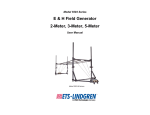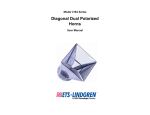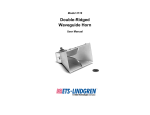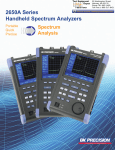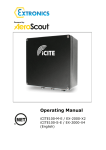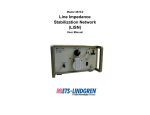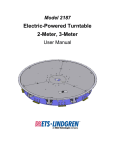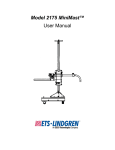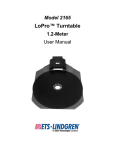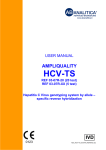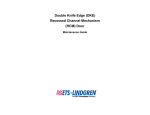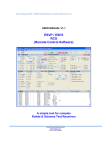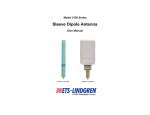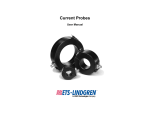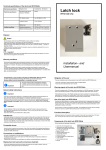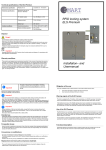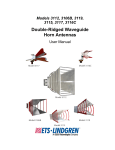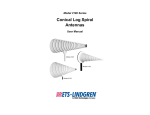Download Bulk Current Injection Probes - ETS
Transcript
Model 95236-1 / Model 95242-1 Bulk Current Injection Probes User Manual ETS-Lindgren L.P. reserves the right to make changes to any product described herein in order to improve function, design, or for any other reason. Nothing contained herein shall constitute ETS-Lindgren L.P. assuming any liability whatsoever arising out of the application or use of any product or circuit described herein. ETS-Lindgren L.P. does not convey any license under its patent rights or the rights of others. © Copyright 2001–2010 by ETS-Lindgren L.P. All Rights Reserved. No part of this document may be copied by any means without written permission from ETS-Lindgren L.P. Trademarks used in this document: The ETS-Lindgren logo is a trademark of ETS-Lindgren L.P. Revision Record MANUAL, CURRENT PROBE, 95236,95242 | Part #399263, Rev. D Revision Description Date A Initial Release October, 2001 B Updates/edits March, 2002 C Updates/edits February, 2005 Remove Model 95252-1; update June, 2010 D frequency range specifications; rebrand ii | Table of Contents Notes, Cautions, and Warnings ................................................ v 1.0 Introduction .......................................................................... 7 Supporting Equipment ................................................................................... 8 Optional Injection Probe ........................................................................ 8 Model 95241-1 Calibration Jig ............................................................... 8 Current Monitoring probes ..................................................................... 8 Operation: Precautionary Measures .............................................................. 9 ETS-Lindgren Product Information Bulletin ................................................. 10 2.0 Maintenance ....................................................................... 11 Annual Calibration ....................................................................................... 11 Service Procedures ..................................................................................... 11 3.0 Specifications..................................................................... 13 Physical Specifications ................................................................................ 13 Electrical Specifications ............................................................................... 14 4.0 Application ......................................................................... 17 Conducted Susceptibility ............................................................................. 17 Typical Test Setup ............................................................................... 17 Test Setup Equipment ................................................................................. 18 Sample Conducted Susceptibility Calibration Setup Diagrams ................... 19 Diagram 1 ............................................................................................ 19 Diagram 2 ............................................................................................ 20 5.0 Conducted Emission: Transfer Impedance .................... 21 Model 95236-1 ............................................................................................. 22 Model 95242-1 ............................................................................................. 23 6.0 Insertion Loss .................................................................... 25 Equipment .................................................................................................... 25 Typical Reference Calibration Setup ........................................................... 25 Procedure .................................................................................................... 26 Appendix A: Warranty ............................................................. 27 | iii This page intentionally left blank. iv | Notes, Cautions, and Warnings Note: Denotes helpful information intended to provide tips for better use of the product. Caution: Denotes a hazard. Failure to follow instructions could result in minor personal injury and/or property damage. Included text gives proper procedures. Warning: Denotes a hazard. Failure to follow instructions could result in SEVERE personal injury and/or property damage. Included text gives proper procedures. See the ETS-Lindgren Product Information Bulletin for safety, regulatory, and other product marking information. | v This page intentionally left blank. vi | 1.0 Introduction The ETS-Lindgren Bulk Current Injection Probe (BCIP) Series is used to inject RF current into conductors and cables of electrical and electronic equipment undergoing susceptibility testing. This manual includes information for these BCIP models: • Model 95236-1 • Model 95242-1 The BCIP provides a means of applying a controlled RF stress level to an instrument under test through interconnecting cables or power cables without requiring a direct connection to the conductor(s) of interest. The models in this series are simply clamped around the test conductor which then becomes a one turn secondary winding, with the current probe forming the core and primary winding of an RF transformer. RF energy can be injected onto single and multi-conductor cables, grounding and bonding straps, outer conductors of shielding conduits and coaxial cables, and so on. Because of the high efficiency design, the probes can also be used as sensors. Frequency Range* Useful Range 95236-1 1 MHz–100 MHz 10 kHz–100 MHz 95242-1 10 MHz–400 MHz 2 MHz–400 MHz * The BCIP Series is especially designed to provide minimum insertion loss over these frequency ranges. Introduction | 7 Supporting Equipment Contact ETS-Lindgren for sizes and sensitivities of other current probes. When using the Model 95242-1 to perform susceptibility tests, the following equipment may be required. OPTIONAL INJECTION PROBE The Model 93686-1 Current Probe with a 6.6 cm window diameter may be used as a bulk current injection probe over the frequency range 50 kHz to 2 MHz. MODEL 95241-1 CALIBRATION JIG The Model 95241-1 Calibration Jig is used in equipment setup for measuring insertion loss of the current probe and is essential to set up equipment for some susceptibility test procedures. CURRENT MONITORING PROBES Suggested current monitoring probes are Model 91550-1 (10 kHz to 100 MHz) and Model 94111-1 (1 MHz to 1 GHz). These probes have a 1.25-inch (3.2-cm) window size and a transfer impedance of 1 ohm to 6 ohms over the 50 kHz to 400 MHz frequency range. 8 | Introduction Operation: Precautionary Measures Before connecting any components, follow the safety information in the ETS-Lindgren Product Information Bulletin included with your shipment. RF fields can be hazardous. Observe appropriate RF exposure limits. When measuring conductors that are not insulated, use extreme care when installing the current probe and taking measurements. If possible, de-energize the test sample during assembly and disassembly of the setup. Also, arrange to center the test conductor in the current probe window for additional voltage breakdown protection. Do not permit the uninsulated current probe connector and cable connectors to come in contact with the ground plane or other nearby conductors. This will prevent possible measurement error due to ground loops, and will avoid danger from high voltages. Ensure that the 50-ohm load is capable of safely dissipating the incurred power. Should the load become disconnected, the developed voltage will be come much greater and may be very dangerous. Introduction | 9 ETS-Lindgren Product Information Bulletin See the ETS-Lindgren Product Information Bulletin included with your shipment for the following: 10 • Warranty information • Safety, regulatory, and other product marking information • Steps to receive your shipment • Steps to return a component for service • ETS-Lindgren calibration service • ETS-Lindgren contact information | Introduction 2.0 Maintenance Before performing any maintenance, follow the safety information in the ETS-Lindgren Product Information Bulletin included with your shipment. Maintenance of the Bulk Current Injection WARRANTY Probe is limited to external components such as cables or connectors. If you have any questions concerning maintenance, contact ETS-Lindgren Customer Service. Annual Calibration See the Product Information Bulletin included with your shipment for information on ETS-Lindgren calibration services. Service Procedures For the steps to return a system or system component to ETS-Lindgren for service, see the Product Information Bulletin included with your shipment. Maintenance | 11 This page intentionally left blank. 12 | Maintenance 3.0 Specifications Physical Specifications Window Diameter: 4.0 cm (1.57 in) Outside Diameter: 13.0 cm (5.11 in) At Widest Point: 10.2 cm (4.01 in) Height: 6.0 cm (2.36 in) Weight: 1.60 kg (3.52 lb) Output Connector: Type N Input Impedance: 50 Ω Specifications | 13 Electrical Specifications 95236-1 95242-1 1 MHz–100 MHz 10 MHz–400 MHz 100 W* 200 W** 20 Amperes 60 Amperes 80°C 80°C 35°C 35°C 30 minutes 30 minutes Turns Ratio: 1:2 1:1 Inductance: 47 μH, ±20% 0.8 μH, ±20% Frequency Range: Maximum Input Power: Maximum Input Current: Maximum Core Temperature: Recommended Maximum Temperature Rise: Maximum Time for Continuous Rating at Full Power: * 95236-1: The power limit of the 95236-1 is 100 W. Powers in excess of 75 W should be used with care to avoid excessive temperature in the equipment under test. Prolonged testing should be avoided, particularly if unattended. ** 95242-1: The power limit of the 95242-1 is 200 W. Powers in excess of 100 W should be used with care to avoid excessive temperature in the equipment under test. Prolonged testing should be avoided, particularly if unattended. 14 | Specifications Insertion Loss (Typical) Useful Range 95236-1 95242-1 dB Range < 15 dB 1 MHz–100 MHz -35 db ± 3 dB @ 10 kHz < 15 dB 10 MHz–400 MHz 10 kHz–100 MHz 2 MHz–400 MHz Specifications | 15 This page intentionally left blank. 16 | Specifications 4.0 Application The principal use of the Bulk Current Injection Probe (BCIP) is for inducing relatively large RF currents into the signal and power circuits of equipment under test for conducted susceptibility. A secondary application would be to use the same probe in a more familiar role as a sensor for measuring weak conducted RF currents. Conducted Susceptibility Conducted susceptibility testing is intended to ensure that RF signals, when coupled on to interconnecting cables and power supply lines of a device under test (DUT), will not cause malfunction or degradation of performance. In addition, this testing can provide an amplitude vs. frequency malfunction signature for the system which, when compared with the levels of current on the cables in a typical operating environment, can assist in the determination of adequate safety margins. TYPICAL TEST SETUP Typical conducted susceptibility tests require that all power and interconnecting cables be tested by subjecting them to the required current or voltage levels, while monitoring the applied current using a current probe. Usually, a reference level calibration is performed using a calibration jig with a specified impedance. This reference curve is then replayed to expose the DUT to a controlled stress level, while a current probe is used to ensure that a low impedance DUT is not overstressed. Some tests may allow the reference calibration to be performed at a lower level and then scaled up to the required power level when applied to the DUT. Entire cables or cable bundles may be tested, or each line may be broken out and tested individually. Some standards may also require simultaneous injection onto multiple cable bundles using several injection probes. Absorbing clamps may be required to isolate peripheral equipment from the DUT, and ensure that only the DUT is exposed to the required stress level. See the pertinent test standard for more details. Application | 17 Test Setup Equipment The following equipment may be needed to set up the test environment. • Current Injection Probes: 95236-1 95242-1 • Calibration Jig 95241-1 • Current Monitoring Probes • Signal Source/Generator • Power Amplifier(s): The power amplifier should be capable of supplying the full rated power into the current injection probes (which have a high VSWR) with a low harmonic content. • Spectrum Analyzer or Measuring Receivers • Directional Coupler • RF Voltmeter(s) • RF Absorbing Clamp • RF Attenuator • RF Loads 18 | Application Sample Conducted Susceptibility Calibration Setup Diagrams DIAGRAM 1 Application | 19 DIAGRAM 2 20 | Application 5.0 Conducted Emission: Transfer Impedance The Bulk Current Injection Probe (BCIP) may also be used as a sensor for measuring conducted emission. The RF current IP (in microamperes) in the conductor under test is determined from the measuring receiver reading of the probe output ES (in microvolts) divided by the probe transfer impedance ZT (in ohms). IP = ES / ZT Or, in dB: IP(dBµA) = ES(dBµV) – ZT(dB) The transfer impedance is determined by passing a known RF current IP through the primary test conductor and noting the voltage ES developed across a 50 ohm load on the probe output. ZT = ES / IP Calibration gig 95241-1 may be used for this determination. Following are the typical transfer impedance values when the BCIP is used as a sensor. High sensitivity and minimal core gap indicate that the current probe should be used only on signal lines where heavy currents are not encountered. Heavy currents may affect measurement accuracy should current probe core saturation occur. Conducted Emission: Transfer Impedance | 21 Model 95236-1 22 | Frequency (MHz) ZT (Ω) 1 16 2 20 3 19 4 19 5 19 6 19 7 19 8 19 9 19 10 19 20 18 30 18 40 17 50 16 60 15 70 14 80 13 90 12 100 11 Conducted Emission: Transfer Impedance Model 95242-1 Frequency (MHz) ZT (Ω) 2 7 4 13 6 19 8 22 10 27 20 25 30 27 40 30 50 32 60 32 70 32 80 30 90 30 100 30 200 33 300 32 400 30 Conducted Emission: Transfer Impedance | 23 This page intentionally left blank. 24 | Conducted Emission: Transfer Impedance 6.0 Insertion Loss Insertion loss of the Bulk Current Injection Probe (BCIP) may be measured at low signal levels. ETS-Lindgren offers this measurement as a calibration service. See the Product Information Bulletin included with your shipment for information on ETS-Lindgren calibration services. Equipment Signal Generator (50 Ohms): 10 kHz to 400 MHz RF Voltmeter (50 Ohms): 10 kHz to 400 MHz Calibration Jig: 95241-1 50 Ohm Termination: VSWR <1.2 Bulk Injection Current Probe: 95236-1 or 95242-1 Typical Reference Calibration Setup Insertion Loss | 25 Procedure 1. Connect the signal generator output directly to the RF voltmeter input as show in Typical Reference Calibration Setup on page 25, indicated by the dashed line. Use the same cables which connected the calibration jig and the injection probe under test. Tune to the test frequency and adjust the signal level for a reference of 0 dBm indication on the RF voltmeter. 2. Without changing control settings, connect the signal generator output to the bulk current injection probe input and connect the calibration jig connector to the RF voltmeter input. 3. Note the RF voltmeter output in dB. The difference between this reading and 0 dB is the insertion loss. In this measurement, the loss cannot be less than 3 dB since half the injected power is absorbed by the 50 ohm termination that is particularly loading (50%) the calibration jig. 26 | Insertion Loss Appendix A: Warranty See the Product Information Bulletin included with your shipment for the complete ETS-Lindgren warranty for your Bulk Current Injection Probe. DURATION OF WARRANTIES FOR BULK CURRENT INJECTION PROBE All product warranties, except the warranty of title, and all remedies for warranty failures are limited to two years. Duration of Product Warranted Warranty Period Model 95236-1 Bulk Current Injection Probe 2 Years Model 95242-1 Bulk Current Injection Probe 2 Years Warranty | 27



























